
Old Style type is based off of the handwriting of early Italian scholars and scribes. They are characterized by thick and thin strokes, and are more refined. Some examples of Old Style are, Adobe Jenson, Garamond, and Bembo.
Transitional fonts were created by Jacques Jaugeon also known as the Romain du Roi or King’s Roman, comm
 issioned by Louis XIV for the Imprimerie Royale in 1692. The fonts were created by a committe set up by the French Academy of Science. The fonts are made of vertical lines with a greater contrast between thick and thin strokes. Some examples of the fonts are, Baskerville, Bookman, Cheltenham, and Joanna.
issioned by Louis XIV for the Imprimerie Royale in 1692. The fonts were created by a committe set up by the French Academy of Science. The fonts are made of vertical lines with a greater contrast between thick and thin strokes. Some examples of the fonts are, Baskerville, Bookman, Cheltenham, and Joanna.Slab Serif fo
 nts began in the earl 19th century, mainly in Britain. Many of the early versions were called "Egyptians" which may have something to do with Napoleon's army had facing off against the British there and hieroglyphics were popular. The difference with this group of fonts is that they are thicker versions of the letterforms. The picture to the left illustrates some examples of the Slab Serif fonts such as, Clarendon, Breugel, Beton, and Figaro.
nts began in the earl 19th century, mainly in Britain. Many of the early versions were called "Egyptians" which may have something to do with Napoleon's army had facing off against the British there and hieroglyphics were popular. The difference with this group of fonts is that they are thicker versions of the letterforms. The picture to the left illustrates some examples of the Slab Serif fonts such as, Clarendon, Breugel, Beton, and Figaro.The first San
 s Serif Typeface was produced in 1816 by an English type foundry. It was 'naked' compared to other fonts until bold antiqua weight and light sans serif were produced. Some examples are, Helvetica, Frutiger, Potima, and Futura.
s Serif Typeface was produced in 1816 by an English type foundry. It was 'naked' compared to other fonts until bold antiqua weight and light sans serif were produced. Some examples are, Helvetica, Frutiger, Potima, and Futura.
Modern is a style developed in the late 18th century which consists of a high contrast between think and thin strokes and flat serifs. They are much harder to read then other typestyles. Some examples are, Bodoni, Didot, and Bernhard Modern Roman.
Scrip
 t typefaces are based upon the varied and often fluid stroke created by handwriting. They are organized into highly regular formal types similar to cursive writing and looser, more casual scripts. Some examples are, Alexa, and Saltino which are calligraphic scripts and Brusch Script and ITC Clover which are casual Scripts.
t typefaces are based upon the varied and often fluid stroke created by handwriting. They are organized into highly regular formal types similar to cursive writing and looser, more casual scripts. Some examples are, Alexa, and Saltino which are calligraphic scripts and Brusch Script and ITC Clover which are casual Scripts.The forceful visual presence of blackletter typestyles evolved from the early handwritten forms of liturgical writings and illuminated manuscripts. Blackletter
 typefaces, sometimes referred to as Gothic or Old English are characterized by a dense black texture and highly decorated caps. The lowercase consists of narrow, angular forms with dramatic thick-to-thin strokes and serifs. They are highly stylized, yet legible. Some blackletter fonts are Crusader, Blackmoor and Lucida Blackletter.
typefaces, sometimes referred to as Gothic or Old English are characterized by a dense black texture and highly decorated caps. The lowercase consists of narrow, angular forms with dramatic thick-to-thin strokes and serifs. They are highly stylized, yet legible. Some blackletter fonts are Crusader, Blackmoor and Lucida Blackletter. As grunge type designer Carlos Segura of T-26 says, ``Typography is beyond letters. Some fonts are so dec orative, they almost become 'visuals' and when put in text form, they tell a story beyond the words--a canvas is created by the personality of the collection of words on the page.'' Grunge typefaces and typography are seen in magazines such as RayGun. Some examples of grunge typography are the work of Barry Deck (Template Gothic, Cyberotica, Truth), Nguyen's Droplet, Goren's Morire and Lin's Tema Cantante.
orative, they almost become 'visuals' and when put in text form, they tell a story beyond the words--a canvas is created by the personality of the collection of words on the page.'' Grunge typefaces and typography are seen in magazines such as RayGun. Some examples of grunge typography are the work of Barry Deck (Template Gothic, Cyberotica, Truth), Nguyen's Droplet, Goren's Morire and Lin's Tema Cantante.
M onospaced fonts are typefaces in which every glyph is the same width. The first monospaced typefaces were designed for typewriters, which could only move the same distance forward with each letter typed. Their use continued with early computers, which could only display a single font. Examples of monospaced typefaces are Courier, Prestige Eliete, Fixedsys, and Monaco. E
onospaced fonts are typefaces in which every glyph is the same width. The first monospaced typefaces were designed for typewriters, which could only move the same distance forward with each letter typed. Their use continued with early computers, which could only display a single font. Examples of monospaced typefaces are Courier, Prestige Eliete, Fixedsys, and Monaco. E
I Love Font
Cheltenham
Slab Serif
Sans Serif
Modern
Script
Blackletter
Grunge
Monospaced

No comments:
Post a Comment